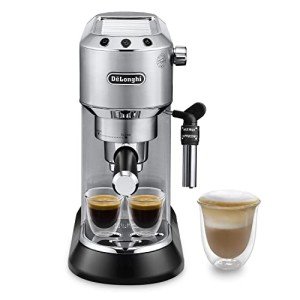An Easy-To-Follow Guide To Heat Exchange Espresso Machines

Heat Exchange Espresso Machines: A Comprehensive Guide
Espresso machines have developed substantially for many years, catering to the requirements of home baristas and coffee professionals alike. Amongst these machines, heat exchange espresso machines have actually acquired appeal due to their capability to provide consistent performance and exceptional brew quality. In this short article, we will explore the functions, advantages, and crucial features of heat exchange espresso machines, offering an extensive understanding for both potential purchasers and coffee enthusiasts.
Comprehending Heat Exchange Technology
Heat exchange espresso machines operate on an unique concept that allows simultaneous water heating for developing and steaming. They are geared up with a single boiler that uses a heat exchanger system. This feature is significant as it makes it possible for users to brew espresso while steaming milk simultaneously, promoting performance in the coffee-making process.
How Does a Heat Exchange Espresso Machine Work?
The procedure starts with the machine's water inlet filling the boiler. As Bean To Cup Espresso Machines warms up, it turns to steam. The ingenious heat exchanger uses hot steam to heat extra water in a separate passage created particularly for the brew group. This implies that water can reach the perfect developing temperature without waiting for the boiler to change. The essential steps consist of:
- Water Fill: Water is drawn into the boiler.
- Heating Process: The boiler warms up as water is converted into steam.
- Heat Exchange: Steam heats water in the heat exchanger tube.
- Brewing: Water from the heat exchanger is pushed through coffee grounds, extracting the flavors required for a rich espresso.
This procedure enables fast temperature modifications and improved coffee extraction.
Advantages of Heat Exchange Espresso Machines
Heat exchange espresso machines use a number of benefits, particularly for those wanting to optimize their coffee experience. Here are some crucial benefits:
- Simultaneous Brewing and Steaming: Users can brew espresso while steaming milk, making it perfect for hectic cafes and home baristas who value efficiency.
- Temperature Stability: The boiler's steam pressure helps keep a steady temperature, which is critical for consistent espresso extraction.
- Adaptability: The design enables quick switching in between brewing and steaming, making it simpler to create various coffee drinks, from lattes to cappuccinos.
- User-friendly: Models frequently include available controls, making it possible for both novices and experienced baristas to produce quality drinks.
- Professional Quality: Heat exchange machines are typically used in commercial settings, providing users with high-quality developing performance in the house.
Secret Features to Look for in Heat Exchange Espresso Machines
When considering the purchase of a heat exchange espresso machine, there are several features that one need to consider:
- Build Quality: Look for machines made from durable products, such as stainless steel or brass, guaranteeing durability.
- Boiler Size: A bigger boiler will hold more water and sustain higher output over time.
- PID Temperature Control: This function helps maintain constant brew temperatures, which can boost the coffee-making process.
- Group Head Design: Machines with a saturated or semi-saturated group head provide better temperature level stability.
- Reduce of Use: User-friendly interfaces and instinctive controls boost the general experience for baristas at all skill levels.
- Steam Wand Quality: An excellent steam wand with proper insulation and flexibility enables better texturing of milk.
- Water Reservoir Size: Depending on your needs, think about how often you desire to fill up the water reservoir.
Contrast of Popular Heat Exchange Espresso Machines
To better comprehend the options readily available in the market, listed below is a comparison table of some popular heat exchange espresso machines:
| Machine Model | Boiler Size | PID Control | Price Range | User Ratings |
|---|---|---|---|---|
| Profitec Pro 700 | 2.0 L | Yes | ₤ 2,000-₤ 2,500 | 9.5/ 10 |
| Rocket Espresso R58 | 1.8 L | Yes | ₤ 2,400-₤ 2,800 | 9.4/ 10 |
| Elekta Bianca | 1.8 L | Yes | ₤ 2,500-₤ 3,000 | 9.6/ 10 |
| La Spaziale S1 Vivaldi II | 1.5 L | Yes | ₤ 1,800-₤ 2,200 | 9.2/ 10 |
| Bezzera Magica | 1.2 L | No | ₤ 1,600-₤ 1,800 | 9.0/ 10 |
FAQs About Heat Exchange Espresso Machines
What is the primary difference in between a heat exchange and a dual boiler espresso machine?
While both types can brew espresso and steam milk at the same time, dual boiler machines have different boilers for brewing and steaming. In contrast, heat exchange machines make use of a single boiler and a heat exchanger to attain the very same function.
Are heat exchange machines ideal for beginners?
Yes! Numerous heat exchange machines are developed with easy to use features, making them accessible for newbies. With proper guidance and practice, users can rapidly produce quality espresso.
What type of upkeep do heat exchange espresso machines require?
Regular maintenance consists of descaling, cleaning up the boiler, examining seals and gaskets, and keeping the group head tidy. informative post ensures durability and consistent efficiency.
Can I use a heat exchange machine for various kinds of coffee drinks?
Absolutely! Heat exchange machines allow users to create a variety of coffee beverages, consisting of espresso, lattes, cappuccinos, and more.
Heat exchange espresso machines represent a mix of innovation and custom, supplying coffee lovers with the tools needed for crafting the best cup. Their capability to at the same time brew and steam, integrated with accurate temperature control, makes them a compelling choice for both home baristas and specialists. With the ideal understanding on features and upkeep, users can open a world of beautiful coffee experiences, making sure that each sip is as delightful as the last.

